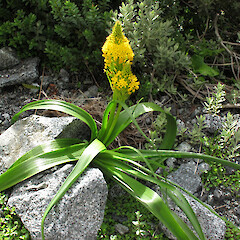Bulbinella gibbsii var. balanifera
Common name
Māori onion
Synonyms
None
Family
Asphodelaceae
Flora category
Vascular – Native
Endemic taxon
Yes
Endemic genus
No
Endemic family
No
Structural class
Herbs - Monocots
NVS code
The National Vegetation Survey (NVS) Databank is a physical archive and electronic databank containing records of over 94,000 vegetation survey plots - including data from over 19,000 permanent plots. NVS maintains a standard set of species code abbreviations that correspond to standard scientific plant names from the Ngä Tipu o Aotearoa - New Zealand Plants database.
BULBAL
Chromosome number
2n = 14
Current conservation status
The conservation status of all known New Zealand vascular plant taxa at the rank of species and below were reassessed in 2017 using the New Zealand Threat Classification System (NZTCS) – more information about this can be found on the NZTCS website. This report includes a statistical summary and brief notes on changes since 2012 and replaces all previous NZTCS lists for vascular plants.
Please note, threat classifications are often suggested by authors when publications fall between NZTCS assessment periods – an interim threat classification status has not been assessed by the NZTCS panel.
- Conservation status of New Zealand indigenous vascular plants, 2017 . 2018. Peter J. de Lange, Jeremy R. Rolfe, John W. Barkla, Shannel P. Courtney, Paul D. Champion, Leon R. Perrie, Sarah M. Beadel, Kerry A. Ford, Ilse Breitwieser, Ines Schönberger, Rowan Hindmarsh-Walls, Peter B. Heenan and Kate Ladley. Department of Conservation. Source: NZTCS and licensed by DOC for reuse under the Creative Commons Attribution 4.0 International licence.
2017 | Not Threatened
Previous conservation statuses
2012 | Not Threatened | Qualifiers: RR
2009 | Not Threatened
2004 | Not Threatened
Distribution
Endemic. North Island and South Island. In the North Island known from the southern Ruahine and Tararua Ranges. In the South Island known from the ranges about Arthur’s Pass south to Fiordland.
Habitat
Alpine in free draining, open habitats such as tussock grassland, the bases of talus slopes and in herbfield. Rarely in subalpine scrub.
Wetland plant indicator status rating
Information derived from the revised national wetland plant list prepared to assist councils in delineating and monitoring wetlands (Clarkson et al., 2021 Manaaki Whenua – Landcare Research Contract Report LC3975 for Hawke’s Bay Regional Council). The national plant list categorises plants by the extent to which they are found in wetlands and not ‘drylands’. The indicator status ratings are OBL (obligate wetland), FACW (facultative wetland), FAC (facultative), FACU (facultative upland), and UPL (obligate upland). If you have suggestions for the Wetland Indicator Status Rating, please contact: [Enable JavaScript to view protected content]
FACU: Facultative Upland
Occasionally is a hydrophyte but usually occurs in uplands (non-wetlands).
Detailed description
Subdioecious, diminutive, summer green, fleshy, lily up to 600 mm tall. Leaves up to 30 mm wide, strap-like, reddish green to dark green, fleshy. Peduncle mostly shorter than raceme, often exceeding leaves. Raceme mostly conical (rarely cylindric), the axis visible between flowers. Pedicels 10–20 mm long, swollen below flower, elongating slightly after anthesis. Bracts shortly-acuminate, notably shorter than pedicel in flowering and fruiting material. Flowers 10–14 mm diameter, dark yellow, numerous, densely crowded; tepals patent, becoming erect and hardening as fruit matures. Stamens 6, < tepals; anthers mostly well filled with pollen. Ovary barrel-shaped, scarcely stipitate. Capsules barrel-shaped. Seeds dark and narrowly winged.
Similar taxa
Bulbinella gibbsii Cockayne var. gibbsii is a smaller plant than var. balanifera with shorter peduncles and pedicels. The subtending bracts greatly exceed the pedicels. The ovary and capsules are broadly ovoid rather than barrel-shaped, and are not slightly stipitate. Bulbinella gibbsii var. gibbsii is confined to Stewart Island/Rakiura.
Flowering
January–February
Flower colours
Yellow
Fruiting
February–June
Propagation technique
Difficult–should not be removed from the wild. Has been cultivated with limited success in the more southerly parts of the country.
Etymology
bulbinella: Little bulb
gibbsii: Named in honor of Frederick G Gibbs (1866-1953)
Where To Buy
Not commercially available.
Attribution
Description modified from: Moore & Edgar (1970).
References and further reading
Moore LB, Edgar E. 1970. Flora of New Zealand, Volume II. Indigenous Tracheophyta: Monocotyledones except Gramineae. Government Printer, Wellington, NZ. 354 p.




